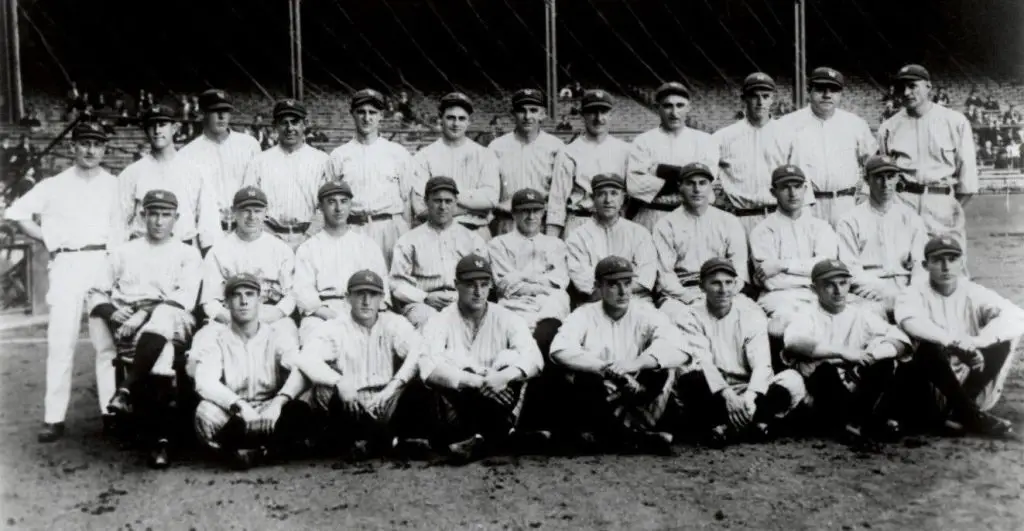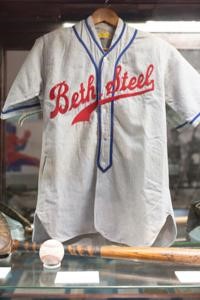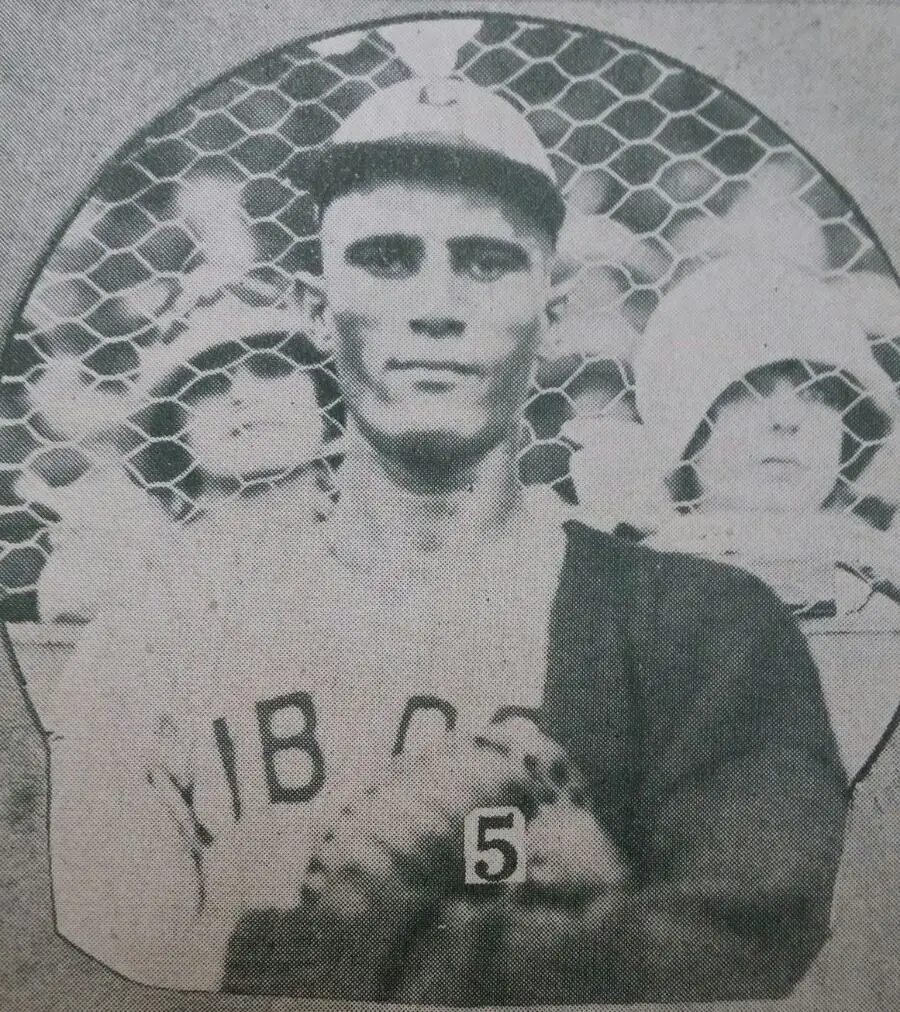
The 1923 New York Yankees (photo) were on their way to winning their first World Series with a month left in the season. It was a unique campaign that began at their brand new Yankee Stadium on April 18, 1923, with a 4-1 win over the Boston Red Sox. New York completed a four-game sweep over the Philadelphia A’s at Shibe Park, September 2-5. Waite Hoyt won the finale, 6-3, helped by Babe Ruth’s thirty-third homer off Hank Huvley, who made his only big-league appearance for the A’s. The Yankees took a train north and stopped in Allentown, 48 miles from Philadelphia. They had time off before a September 8 make-up game in Washington, D.C., 188 miles south of Allentown. So, why did the Yankees accept an invitation to play semi-pro Allentown Dukes at 3:45 p.m. on Thursday, September 6, 1923?
Allentown Welcomes the 1923 New York Yankees
Ernest C. «Duke» Landgraf, the Duke’s owner, was responsible for setting up this game, but how he managed to get the Yankees to come to Allentown for an exhibition game is unknown. «It was not uncommon at that time,» wrote Evan Burian, a local sports writer in 2013,» for major league teams to travel to smaller cities by train to play independent baseball teams on their open dates during the regular season.» History’s Headlines: The year the Yankees lost in Allentown | History’s Headlines | wfmz.com. This game was first publicized in the Morning Call, Allentown’s newspaper, with the headline «YANKEES PLAY HERE ON NEXT THURSDAY»:
The August 31, 1923, Morning Call proclaimed: «Next Thursday promises to be a red-letter day for the baseball fans in the Lehigh Valley, for on that occasion, Manager Miller Huggins will bring his entire first-string lineup of the New York Yankees to this city to meet the «Allentown Dukes,» the game to be called at three forty-five o’clock.» The Yankees arrived on the Lehigh Valley Railroad’s Black Diamond; their rooms were reserved at the Hotel Traylor. Paid attendance was 4,000, double the 2,000 who saw the Yankees defeat the A’s at Shibe Park on September 5! Landgraf set ticket prices at $1.10 apiece. Thus, $4,400 in gate receipts in 1923 translates to $77,272.59 in 2023 dollars,. And $1.10 per person in 1923 equals $19.32 in 2023.
Allentown Upsets the Yankees, 8-7
The Yankees jumped ahead, 5-0, and made it 7-1 before the Dukes rallied, making it a 7-7 tie. In the top of the ninth, Babe Ruth struck out against Dukes’ pitcher George «Scrap Iron» Papsin. According to Ruth: «That boy had something on his ball; he crossed me all around,» the Bambino said as he gulped water from the dipper in the dugout. «I wanted to knock that first ball a mile, and when I missed that first one, I figured he was going to throw me a slow one. Instead, it was a fast hook inside. The third one looked good, and I bit for it. I missed that one, though.» Allentown scored the game-winner in the home night with two outs as Dukes’ right fielder Buster Dell singled to right, to the fans’ delight. Before the game, Malcolm Gross, Allentown’s mayor, welcomed Babe Ruth to Edgemont Field at 920 Second South Street.

Edgemont Field, September 6, 1923. Babe Ruth (L) and Malcolm Gross (R), Mayor, Allentown, PA. Photo Credit: https://www.facebook.com/LehighValleyHistory/photos/photo-of-babe-ruth-and-allentown-mayor-malcolm-gross-on-september-6-1923-babe-ru/2744081502363120/
Babe Ruth also spent some time in Pennsylvania’s Lehigh Valley in the latter part of World War I at a steel plant in Lebanon. His job title was: «print messenger,» responsible for delivering blueprints. The 1918 big league season and World Series ended early due to the «Great War.»

Example of Bethlehem Steel Uniform, Bethlehem Steel Industrial League (Sept. 1918). Babe Ruth played a September 27, 1918, game for Lebanon. Photo Credit: National Museum of Industrial History/Glenn Koehler Photography.
Babe Ruth’s Statistical Legacy
Ruth’s 1923 «slash» line was .393/.545..764 (B.A., OBP, SLG), with a 1.309 OPS (OBP + SLG). His career OPS was 1.164, an all-time best. In 1923, his Weighted On-Base average (wOBA) was .569, and his career wOBA was .513! In 1923, a single was worth .942; double, 1.353; triple, 1.717; home run, 2.217 since «not all hits are created equal.» wOBA factors vary slightly from year to year but are a more comprehensive indicator than simply B.A., SLG, and so on.
“Duke” Landgraf Scouts Gacho Torres, Agustín “Tingo” Daviú and Others in Puerto Rico
The «spillover effect» of Allentown’s 8-7 win vs. the New York Yankees resulted in an invitation for Allentown to play some January 1924 (and January 1925) barnstorming games in Puerto Rico. Duke Landgraf was impressed with Gacho Torres, who pitched and could play first base and the outfield. Gacho, a lefty, played for the 1925 semi-pro Allentown Dukes before participating in at least two games with the 1926 Newark Stars, Eastern Colored League (ECL). Those two games made Gacho Torres Puerto Rico’s FIRST major leaguer due to Commissioner Rob Manfred’s December 16, 2020 ruling, granting MLB status to seven (7) Negro Leagues between 1920 and 1948, including the ECL. Gacho preceded Hiram Bithorn of the 1942 Chicago Cubs by 16 years as Puerto Rico’s first big leaguer.
The «quartet» that impressed Landgraf included Gacho, Daviú, Rafael Net, and Baldomero «Mero» Ureña (a Dominican pitcher). All four played for the 1925 Allentown Dukes. Some Island teams, circa 1923-27, were Ribosch de Cayey, Humacao Stars, Arecibo Wolves,
Guayama Stars, and 1924 Ponce, ably managed by captain Pedro Miguel Caratini. In December 1925, the Brooklyn Royal Giants, with infielder George Scales and other Negro Leaguers, delighted Puerto Rico fans with their play, as did other ballclubs with African-American players.

José ¨Gacho¨Torres
Circling back to Gacho Torres, one (and other) Stateside sportswriters incorrectly mentioned him as a Cuban player. Scribes called him Joe Gacho or Tony Gacho! One press clipping noted: «If present plans go through, Owner Landgraf will have another Porto Rican player on his [1925] staff of Allentown Dukes very shortly, [with] the Duke now dickering for a player on the tropical island who is said to be the real thing.» It continued: «His name is Tony Gacho, and besides being a great hitter and outfielder, he is a left-handed pitcher of no mean ability. During the last Porto Rican tour of the Dukes, he broke up several games at San Juan with home run drives. Before playing in Porto Rico, he earned the Home Run King of Panamá title. Two valuable websites are https://agatetype.typepad.com/agate_type/2015/02/gacho-torres.html and
https://negroleaguerspuertorico.com/player/jose-gacho-torres/.
Gacho’s Stateside baseball experience with 1925 and 1926 Allentown and 1926 Newark Stars—who folded after 11 games—was relatively brief. [But] unlike Babe Ruth—who had a «cushy» industrial job toward the end of World War I—Gacho served in the U.S. Military (World War I), as many Puerto Ricans have honorably done in both World Wars, Korea, Vietnam, Desert Storm, Iraq, Afghanistan…for more than a century. (Puerto Rico has been a U.S. Territory since 1898—for the past 125 years.) Gacho also, post-World War I, was a physical education instructor at the University of Puerto Rico in Rio Piedras, the sector of San Juan, where he was born on July 2, 1896. He died in Cayey, Puerto Rico, at age 67, on December 14, 1963. Gacho, as a player, was listed at 5’11» and 172 pounds.
If the 1923 Allentown Dukes do not host the 1923 New York Yankees, it is doubtful that Duke Landgraf’s team was invited to barnstorm in Puerto Rico during the 1923-24 and 1924-25 «off-seasons.» And Gacho Torres is a footnote and never becomes Puerto Rico’s first big leaguer.
Post-Script
Allentown is Pennsylvania’s third-largest city, population-wise, with 125,845 residents as of the most recent census. It has a significant number of residents from Puerto Rico (including those who moved there or were born there), estimated at 25 percent of the city’s population. Pennsylvania, statewide, saw its Puerto Rican population increase by about 30 percent between 2010 and 2019 (pre-COVID-19), from 378,312 in 2010 to 493,255 in 2019. This figure probably surpassed the 500,000 mark in recent years. Philadelphia (city) has about 1.6 million residents, while Pittsburgh (city) includes 304,000 residents. These do not include their metro area population.
Finally, the former Edgemont Park location, where the Allentown Dukes defeated the New York Yankees, 8-7, on Thursday, September 6, 1923, is now the St. Paul Roman Catholic Church.

St. Paul Roman Catholic Church, 920 South Second Street, Allentown, PA, site of former Edgemont Park, where the New York Yankees played the Allentown Dukes, on September 6, 1923. Photo Credit: St. Paul Roman Catholic Church (Parroquia San Pablo), Allentown, Pennsylvania.
Special thanks to Historian Jorge Colón Delgado for his research on José «Gacho» Torres and valuable ongoing research on Negro Leaguers who barnstormed in Puerto Rico and who played professionally in Puerto Rico’s Winter League for some three decades (1938-1968). Jorge did the editing and photo placement. Thanks to Gary Ashwill, Seamheads Negro Leagues Database, Rafael Costas (deceased), and Héctor Díaz Salichs.

